By Ruby Smith, 2nd Year, English Literature.
Film production creates a lot of waste. Whether its copies of hundred-page scripts, unworn costumes, the energy used to light up sets or the flights to remote filming locations, almost every element of film production creates a negative environmental impact. While film is nobody’s first thought when discussing climate change, such a large and influential industry should surely be held to account more often.
In a report done by the Environmental Production Agency, researchers found that big-budget films created a carbon footprint averaging around 3,000 metric tons on each production. To rationalise this with more normal people's standards, that’s around the equivalent of 7 million miles driven in a car, or charging a mobile phone 360 million times.
So, however you put it, blockbuster films have a terrible impact on the environment.

Hollywood, as with everyone else in the world, is aware of the climate situation and as films have always been tools for social and political critique, it’s no surprise we have seen our fair share of films on climate change, despite the industries contributing factors. Industry giants like Netflix have produced global blockbusters bringing awareness to global warming.
The 2021 documentary, Seaspiricy explored the environmental impact of the global fishing industry. The response was widely positive, with the film being in the top ten most watched in many countries as well as trending on social media. Exploring worldwide impacts on climate, the film seemed to spark important conversations on industry practices. Furthermore, Don’t Look Up (2021) was also produced by Netflix. Its satirical take on society’s reaction to climate change immediately sparked both controversy and support on its takes on environmental politics.

However, a layer of irony is clear with these films. Despite being funded and praised by environmental experts, Netflix itself seems to be a questionable source of education. The company’s net emissions rose almost 50% from 2020 to 2021, despite its goals to reach a net zero production. Netflix is not the only culprit however. Many streaming and production companies have hard to find numbers on carbon emissions, leaving customers to question just how much environmental impact is created.
The brutal facts of climate change and the role of major companies in creating it can be really quite depressing, especially when as individuals our recycling and energy saving efforts seem wasted in comparison. However, we have seen a recent change in production practices – a light at the end of the tunnel if you will – that has come from consumer pressure. NBC Universal (the industry superpower that owns major film and TV productions such as NBC, Peacock, Universal, Bravo etc.) have created their Sustainable Production Program which includes a positive shift in production practices.

Their recent example has been Fast X (2023), the latest installment of the Fast and Furious saga. The production utilised sustainable consulting teams to advise them on day-to-day practices. Being based around cars, the previous films’ productions have often been emission heavy, but making the choice to use electric and less-diesel cars created a massive change in net impact. The film production also followed the principles of the sustainability program; energy efficient set lighting, reused and recycled sets and props and donations of surplus food all helped to contribute to the sustainable practices of the production.
These kinds of climate-saving practices are also proving to be beneficial to the production companies themselves. Scripps News claims that the production of The Amazing Spider-Man 2 (2014) saved over $400,000 by using reusable resources and sourcing costume pieces from local markets. Examples like these are positively encouraging companies to consider the reusing and re-purposing of materials to benefit them financially as well as environmentally.

While the impact of the film industry is clear, there does seem to be steps being taken to increase the sustainability of film production. However, while this issue goes undiscussed, production companies are under less consumer pressure to make changes to their practices.
So, as ever, stay vigilant and aware of what companies you support and who is making those extra steps to save our planet.
How can the film industry take a green approach?








